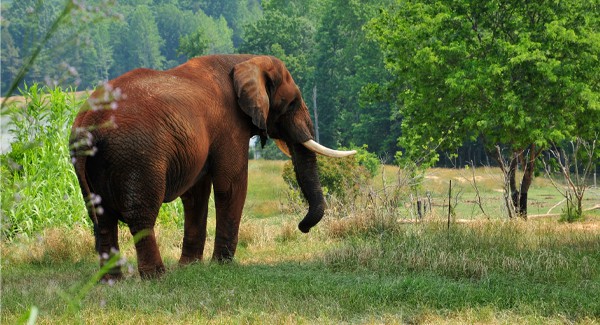
Last Updated on August 30, 2024
The North Carolina Zoo is home to an abundance of wildlife from African elephants to zebras, with plenty of attractions in between.
The world’s largest natural habitat zoo is located on 2,600 acres just south of Asheboro in Randolph County. Selected for its location in the heart of the Tar Heel State, the zoo is 75 miles northeast of Charlotte, 25 miles south of Greensboro, and 75 miles west of Raleigh.
More than 1,800 animals call the zoo home, but the destination also offers attractions, hiking trails, and educational programs including camps.
Located at 4401 Zoo Parkway in Asheboro, the North Carolina Zoo is open daily except Thanksgiving and Christmas Day. I
n-season hours are 9 a.m. to 5 p.m. April through October, and off-season hours are 9 a.m. to 4 p.m. November through March.
NC Zoo admission prices

A one-day ticket to the North Carolina Zoo is $15 for adults, $11 for children 2-12, and $13 for seniors 62 and older.
If you plan to visit the zoo multiple times per year, consider becoming a member. Annual membership prices vary depending on the number of guests, including $69 for an individual and $109 for a family.
A zoo membership provides 12 months of free admission plus free or discounted admission to more than 150 partner zoos and aquariums across the U.S.
Members also receive a subscription to “Alive,” the Zoo Society’s quarterly magazine with insider information on upcoming events as well as updates on the conservation efforts of the zoo.
“Ride and a Guide” tours are also offered for small groups who want to experience the zoo with a professional guide.
Tours can be booked Monday through Friday with at least two weeks notice by calling 336.879.7262 or 336.879.7251. Prices range from $165 for 1.5 hours to $190 for 3 hours. (Members save $15 on these prices.)
Getting Around at the North Carolina Zoo

If you want to see everything at the zoo in one day, plan to spend 3-5 hours and wear comfortable shoes so you can enjoy the five miles of walking trails that meander through the wildlife habitats and attractions.
Bring a refillable water bottle and make use of the multiple water refilling stations available to visitors throughout the grounds.
Guests are allowed to bring their own strollers, or the zoo provides rentals at the Earth Explorers Store in North America and the Safari Gift Shop in Africa’s Akiba Market.
An in-park tram picks up and drops off guests at three stops: North America, Africa, and Junction Plaza. The trams are free and can accommodate wheelchairs and strollers.
Animals are not visible from the trams and guests may have to wait up to 30 minutes to be picked up, although thankfully the waiting areas are shaded.
If you finish your visit at the opposite end of the zoo from where you parked, just take one of the free parking lot shuttles back to your car.
These shuttles arrive more frequently than the in-park trams, so it’s a better way to get from one end of the grounds to the other if you have already exited the zoo.
Must-See Wildlife at the North Carolina Zoo

The first region to open at the zoo was Africa, in 1980. From the Africa entrance it’s a short walk to the Forest Edge habitat, 3.5 acres modeled after the lightly-wooded savannas of Kenya.
Giraffes, zebras, and ostriches live together in this habitat, which has four viewing areas.
At the nearby Watani Grasslands Reserve, elephants, antelope, gazelles, rhinos, waterbucks, ostriches, and greater kudu are free to roam 40 acres. The elephants are particularly entertaining, so if you don’t see them at one viewing area, keep looking at the others.
On the other side of the walking trail that circles the Africa region, you’ll see the African lions. Weighing in at more than 400 pounds, these big cats, considered vulnerable on the Endangered Status list, are not to be missed.
As you continue following the walking path, veer onto Chimp Loop and try to spot a chimpanzee in the Kitera Forest habitat.
Sadly, these social animals are endangered, and the North Carolina Zoo is working with anti-poaching teams to help provide a safe environment for them in Uganda’s Kibale National Park.
Before you exit Africa for Junction Plaza, stop by Lemur Island to view two species of lemurs, the ring-tailed and red-ruffed.
These playful creatures spend lots of time in the trees and use vocal cues to communicate with their group, so you may get to hear some lemur-speak!
The final must-see stop before you get to Junction Plaza is the Forest Aviary, where more than 100 exotic birds coexist with tortoises and poison dart frogs in a lush, tropical setting whose sights, sounds, and floral scents will transport you to a faraway forest.
Wildlife abounds as you pass through Junction Plaza and enter North America. Be sure to visit the ocelots, which are common in Central and South America but are exceptionally rare in the U.S.
These uniquely patterned animals live in the desert habitat along with vampire bats, the cape porcupine (which is surprisingly large), and a variety of reptiles.
As you continue through the North America region, make a stop at the Red Wolves habitat and see if you can spot any pups.
Once declared extinct in the wild, these wolves can only be found in extreme northeastern North Carolina and are classified as critically endangered.
Four viewing areas provide a look at life on the Prairie, the habitat where bison and elk live together. Further down the path you’ll find the Streamside habitat, home to bobcats, owls, venomous snakes including the timber rattlesnake, and the entertaining North American river otters.
The nearby Rocky Coast habitat is home to polar bears, arctic foxes, harbor seals, and horned puffins. Look for signs near the harbor seals that advise when their training time is, because it is worth seeing them do tricks for treats!
The Rocky Coast is one of a few habitats with air-conditioned indoor areas to cool off while you view the wildlife.
The last habitat before the North America exit is the Cypress Swamp, which cougars, turtles, alligators and several amphibians call home. The American alligator and alligator snapping turtle are both must-see wildlife.
Looking for a specific animal? Find an alphabetical list of all wildlife currently at the zoo here.

Other Activities at the NC Zoo
Between habitats, the North Carolina Zoo offers fun activities and attractions for all ages, including the Air Hike Ropes Course, Garden Friends
Playground, Kaleidoscope Butterfly Garden, Treehouse Trek, and Kidzone. Some of these attractions require a small fee in addition to the cost of zoo admission. Find a complete list of attractions and prices here.
With so much to see and do, you will probably need to stop for a meal break while you’re at the zoo. Guests are allowed to bring their own bottled, non-alcoholic drink and a snack into the zoo. However, zoo members are allowed to bring in their own meals and have a picnic in specific areas of the zoo.
The zoo has four restaurants and seven seasonal snack bars located throughout the grounds, ensuring that everyone can find something to enjoy. All restaurants and seasonal snack bars accept cash, Visa, Mastercard, American Express, Discover, Apple Pay, Google Pay and Zoo gift cards.
Learn more about the North Carolina Zoo or purchase your tickets at www.NCZoo.org.
Looking for more easy trips in the Carolinas? Check out these 15 spectacular weekend getaways close to Charlotte.



